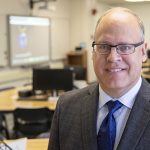Dear Friends of UConn Physics,
Last year, I wrote to you as a new Interim Head of Physics and only barely a month into my appointment. During the past year, we conducted a search for a permanent head and I was selected. For this, I am very grateful for the trust and support I received from the department. The past year has been a bit of a rollercoaster: on the one hand, the complex budget situation has preoccupied the department heads and upper administration and student protests sparked discussions about free speech and activism on campus. On the other hand, the Physics Department had another excellent year in terms of research, teaching, and outreach and I had the pleasure of meeting several of our generous donors.
The most notable achievements of the past year were the election of Prof. Nora Berrah to the National Academy of Sciences, one of the highest honors in science, and her appointment as a UConn Board of Trustees Distinguished Professor, the highest honor at UConn. These will be celebrated at a special Edward Pollack Distinguished Lecture, on October 14, 2024, given by a longtime friend and colleague of Nora’s, Prof. Philip Bucksbaum, himself a member of the National Academy of Sciences and the Marguerite Blake Wilbur Professor in Natural Science at Stanford University.
A number of other faculty received notable awards this year. Prof. Moshe Gai will travel to Romania on a U.S. Fulbright Scholarship. Two faculty received awards from the College of Liberal Arts and Science (CLAS): Prof. Peter Schweitzer for Faculty Mentoring of Faculty and Prof. Erin Scanlon for promoting Climate, Diversity, Equity, and Inclusion. CLAS also funded a Diversity, Equity, and Inclusion Initiative: “UConn STARs (Science, Technology, and Astronomy Recruits),” Prof. Cara Battersby, PI.
We gave out our two undergraduate awards: the Katzenstein prize for the best undergraduate research paper went to Danya Alboslani and our Mark Miller award to fund a summer research project went to Leilani Ainsworth, working with Prof. Simone Colombo
We are fortunate to welcome two new faculty this year:
- Assistant Professor Aleksandra Kuznetsova is currently a fellow at the Flatiron Institute and works on star and planet formation. She will join us this August.
- Assistant Professor Shohini Bhattacharya currently holds an Oppenheimer Fellowship at Los Alamos National Laboratory in theoretical nuclear physics and will join us in January 2025.
This was also a great year for outreach. We welcomed over 100 enthusiastic second graders for a variety of hands-on activities, organized by Prof. Jason Hancock and Sarah Trallero. We held a viewing party for the opening of our newly renovated observatory, spearheaded by Prof. Matt Guthrie and we got permission to officially name it in honor of the late Prof. Cynthia Peterson, who funded and built the observatory in 1980. And, we had another exciting eclipse viewing party organized by Prof. Jonathan Trump – the second in seven years! We are looking forward to hosting CU*IP: Conference for Undergraduate Women and Under-represented Minorities in Physics, sponsored by the American Physical Society. It will take place in January2025 and is being organized by Prof. Nora Berrah, along with a large local organizing committee. Finally, I would like to cordially invite you to attend our 26th annual Katzenstein Distinguished Lecture on Friday, November 15, 2024, which will be held in our department. This year’s speaker is Professor Adam Riess from Johns Hopkins University where he is the Bloomberg Distinguished Professor. He was a joint winner, with Drs. Saul Perlmutter and Brian P. Schmidt, of the 2011 Nobel Prize for Physics, awarded “for the discovery of the accelerating expansion of the Universe.” I hope you can all attend and catch up on everything that is going on in the department and the Universe! I look forward to seeing you there.
Sincerely,
George Gibson
Department Head, Physics
